Designed for storm water management and control by the use of a chain of several lakes, the Gordon River Water Quality Park in Naples, Fla., cleans water as it travels through both man-made and natural wetlands. The 50-acre site also serves as a passive and educational park with 3 mi of pathways and boardwalks through the lakes, gardens and wetlands. There are several buildings on the site, restroom facilities, pavilions and an educational building.

The project was designed to treat storm water runoff from area roads before directing it to the Gordon River. The innovative design incorporates four lakes, uplands and wetlands that serve as water retention and cleaning areas for polluted storm water runoff before it eventually reaches the river and Naples Bay to the south. Water travels through the series of lakes until it is dispensed at the end of the system.
The new facility incorporates approximately 3,800 ft of boardwalks and 2 mi of walking paths. Pavilions were constructed to allow visitors to enjoy the views of the lakes and surrounding nature. The boardwalks were built using a hardwood from Brazil that resists insects and water damage. The understructure pilings are from Brazil as well, and also insect-resistant.
The project also required the planting of more than 10,000 new native plants and trees throughout the park. Also, to enhance the design, the project team added a waterfall by diverting the storm water into a structure that directed the flow over a rock formation.
The park also features a 2,400-sq-ft educational building for student field trips, study programs and environmental projects.
During the clearing process, the project team had to remove all exotic plantings, without damaging or removing the native plants that would remain. Originally, no equipment or machinery was to be brought into the wetlands.
One of the contractor’s biggest challenges was building a raised boardwalk through the wetlands without damaging or disturbing any part of the area. Construction of the boardwalks required the installation of more than 1700, 20-ft pilings. Due to especially deep mud, however, the project team requested that the county allow them to use crane mats so a small machine could set the pilings. The contractor used a small track-hoe with a 5-ton vibrating hammer on it to drive the pilings.
In addition to achieving these environmental and community benefits, the project solved the county’s problem of flooding in the area from summer storms.
Key Facts
Owner: Collier County, Naples, Fla.
Location: Naples, Fla.
Cost: $10.3 million
General Contractor: Kraft Construction Co., Naples
Design Firm: CH2M-Hill




